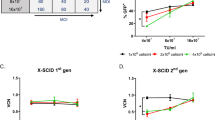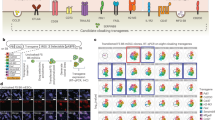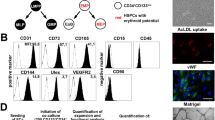Abstract
To develop a cellular vehicle able to reach systemically disseminated areas of angiogenesis, we sought to exploit the natural tropism of circulating endothelial progenitor cells (EPCs). Primate CD34+ EPCs were genetically modified with high efficiency and minimal toxicity using a non-replicative herpes virus vector. These EPCs localized in a skin autograft model of angiogenesis in rhesus monkeys, and sustained the expression of a reporter gene for several weeks while circulating in the blood. In animals infused with autologous CD34+ EPCs transduced with a thymidine kinase-encoding herpes virus, skin autografts and subcutaneous Matrigel pellets impregnated with vascular growth factors underwent necrosis or accelerated regression after administration of ganciclovir. Importantly, the whole intervention was perfectly well tolerated. The accessibility, easy manipulation, lack of immunogenicity of the autologous CD34+ cell vehicles, and tropism for areas of angiogenesis render autologous CD34+ circulating endothelial progenitors as ideal candidates for exploration of their use as cellular vehicles when systemic gene delivery to those areas is required.
This is a preview of subscription content, access via your institution
Access options
Subscribe to this journal
Receive 12 print issues and online access
$259.00 per year
only $21.58 per issue
Buy this article
- Purchase on Springer Link
- Instant access to full article PDF
Prices may be subject to local taxes which are calculated during checkout





Similar content being viewed by others
References
Kong HL, Crystal RG . Gene therapy strategies for tumor antiangiogenesis J Natl Cancer Inst 1998 90: 273–286
Folkman J . Antiangiogenic gene therapy Proc Natl Acad Sci USA 1998 95: 9064–9066
Kluth D . Inflammation, genes and gene therapy JR Coll Phys Lond 1998 32: 167–170
Knechtle SJ, Zhai Y, Fechner J . Gene therapy in transplantation Transplant Immunol 1996 4: 257–264
Anderson WF . Human gene therapy Nature 1998 392: 25–30
Bilbao G, Contreras JL, Gomez-Navarro J, Curiel DT . Improving adenoviral vectors for cancer gene therapy Tumor Targeting 1998 3: 59–79
Thurston G et al. Cationic liposomes target angiogenic endothelial cells in tumors and chronic inflammation in mice J Clin Invest 1998 101: 1401–1413
Kay MA, Liu D, Hoogerbrugge PM . Gene therapy Proc Natl Acad Sci USA 1997 94: 12744–12746
Vrancken PM, Perkins AL, Kay MA . Method for multiple portal vein infusions in mice: quantitation of adenovirus-mediated hepatic gene transfer Biotechniques 1996 20: 278–285
Worgall S, Wolff G, Falck-Pedersen E, Crystal RG . Innate immune mechanisms dominate elimination of adenoviral vectors following in vivo administration Hum Gene Ther 1997 8: 37–44
Kafri T et al. Cellular immune response to adenoviral vector infected cells does not require de novo viral gene expression: implications for gene therapy Proc Natl Acad Sci USA 1998 95: 11377–11382
Paillard F . Mesothelial cells: the panacea for ex vivo gene therapy? Hum Gene Ther 1997 8: 1839–1840
Gage FH . Cell therapy Nature 1998 392: 18–24
Smith A . Cell therapy: in search of pluripotency Curr Biol 1998 8: R802–R804
Rancourt C et al. Endothelial cell vehicles for delivery of cytotoxic genes as a gene therapy approach for carcinoma of the ovary Clin Cancer Res 1998 4: 265–270
Asahara T et al. Isolation of putative progenitor endothelial cells for angiogenesis Science 1997 275: 964–967
Shi Q et al. Evidence for circulating bone marrow-derived endothelial cells Blood 1998 92: 362–367
Stump MM, Jordan GLJ, DeBakey ME, Halpert B . Endothelium grown from circulating blood on isolated intravascular Dacron hub Am J Pathol 1963 43: 361–363
Gonzalez IE, Vermeulen F, Ehrenfeld WK . Relations between circulating blood and pathogenesis of atherosclerosis Isr J Med Sci 1969 5: 648–651
Kennedy LJJ, Weissman IL . Dual origin of intimal cells in cardiac-allograft arteriosclerosis New Engl J Med 1971 285: 884–887
Frazier OH, Baldwin RT, Eskin SG, Duncan JM . Immunochemical identification of human endothelial cells on the lining of a ventricular assist device Tex Heart Inst J 1993 20: 78–82
Scott SM, Barth MG, Gaddy LR, Ahl ET Jr . The role of circulating cells in the healing of vascular prostheses J Vasc Surg 1994 19: 585–593
Shi Q et al. Proof of fallout endothelialization of impervious Dacron grafts in the aorta and inferior vena cava of the dog J Vasc Surg 1994 20: 546–556
Rafii S et al. Characterization of hematopoietic cells arising on the textured surface of left ventricular assist devices Ann Thorac Surg 1995 60: 1627–1632
Young PE, Baumhueter S, Lasky LA . The sialomucin CD34 is expressed on hematopoietic cells and blood vessels during murine development Blood 1995 85: 96–105
Kabrun N et al. Flk-1 expression defines a population of early embryonic hematopoietic precursors Development 1997 124: 2039–2048
Eichmann A et al. Ligand-dependent development of the endothelial and hemopoietic lineages from embryonic mesodermal cells expressing vascular endothelial growth factor receptor 2 Proc Natl Acad Sci USA 1997 94: 5141–5146
Shalaby F et al. A requirement for Flk1 in primitive and definitive hematopoiesis and vasculogenesis Cell 1997 89: 981–990
Caprioli A et al. Blood-borne seeding by hematopoietic and endothelial precursors from the allantois Proc Natl Acad Sci USA 1998 95: 1641–1646
Choi K et al. A common precursor for hematopoietic and endothelial cells Development 1998 125: 725–732
Hatzopoulos AK et al. Isolation and characterization of endothelial progenitor cells from mouse embryos Development 1998 125: 1457–1468
Nishikawa SI et al. Progressive lineage analysis by cell sorting and culture identifies FLK1 + VE-cadherin+ cells at a diverging point of endothelial and hemopoietic lineages Development 1998 125: 1747–1757
Labastie MC et al. Molecular identity of hematopoietic precursor cells emerging in the human embryo Blood 1998 92: 3624–3635
Hirashima M, Kataoka H, Nishikawa S, Matsuyoshi N . Maturation of embryonic stem cells into endothelial cells in an in vitro model of vasculogenesis Blood 1999 93: 1253–1263
Cleaver O, Krieg PA . VEGF mediates angioblast migration during development of the dorsal aorta in Xenopus Development 1998 125: 3905–3914
Shalaby F et al. Failure of blood-island formation and vasculogenesis in Flk-1-deficient mice Nature 1995 376: 62–66
Medin JA, Karlsson S . Viral vectors for gene therapy of hematopoietic cells Immunotechnology 1997 3: 3–19
Dunbar CE et al. Transduction of hematopoietic stem cells in humans and in nonhuman primates Stem Cells 1997 15 (Suppl 1): 135–139; discussion 139–140
Havenga M, Hoogerbrugge P, Valerio D, van Es HH . Retroviral stem cell gene therapy Stem Cells 1997 15: 162–179
Hennemann B et al. Optimization of retroviral-mediated gene transfer to human NOD/SCID mouse repopulating cord blood cells through a systematic analysis of protocol variables Exp Hematol 1999 27: 817–825
Douglas JT et al. A system for the propagation of adenoviral vectors with genetically modified receptor specificities Nat Biotechnol 1999 17: 470–475
Case SS et al. Stable transduction of quiescent CD34 (+)CD38(−) human hematopoietic cells by HIV-1-based lentiviral vectors Proc Natl Acad Sci USA 1999 96: 2988–2993
Chatterjee S et al. Transduction of primitive human marrow and cord blood-derived hematopoietic progenitor cells with adeno-associated virus vectors Blood 1999 93: 1882–1894
Miyoshi H et al. Transduction of human CD34+ cells that mediate long-term engraftment of NOD/SCID mice by HIV vectors Science 1999 283: 682–686
Briones J et al. Retroviral gene transfer into human hematopoietic cells: an in vitro kinetic study Haematologica 1999 84: 483–488
Tisdale JF et al. Ex vivo expansion of genetically marked rhesus peripheral blood progenitor cells results in diminished long-term repopulating ability Blood 1998 92: 1131–1141
Dilloo D et al. A novel herpes vector for the high-efficiency transduction of normal and malignant human hematopoietic cells Blood 1997 89: 119–127
Watanabe T et al. Gene transfer into human bone marrow hematopoietic cells mediated by adenovirus vectors Blood 1996 87: 5032–5039
Neering SJ et al. Transduction of primitive human hematopoietic cells with recombinant adenovirus vectors Blood 1996 88: 1147–1155
Seth P et al. Adenovirus-mediated gene transfer to human breast tumor cells: an approach for cancer gene therapy and bone marrow purging Cancer Res 1996 56: 1346–1351
Marini FC, Zhang X, Trapnell B, Andreeff M . Inefficient infection of primitive hematopoietic precursors cells (CD34+) using CMV driven adenoviral vectors (ad-v) Blood 1996 88 (Suppl 1): 292b
Garcia Sanchez F et al. Use of a safety recombinant adenovirus vector for selective bone marrow purging carrying the chemosensitization gene cytosine deaminase International Society of Hematology, Charlottesville, VA, Carden Jennings 1996 Abstr. 619: 1138
Fu SQ, Garcia Sanchez F, Chung I, Deisseroth AB . Adenoviral vectors and hematopoietic cells Blood 1997 89: 1460–1467
Frey BM et al. High-efficiency gene transfer into ex vivo expanded human hematopoietic progenitors and precursor cells by adenovirus vectors Blood 1998 91: 2781–2792
Miller DG, Adam MA, Miller AD . Gene transfer by retrovirus vectors occurs only in cells that are actively replicating at the time of infection Mol Cell Biol 1990 10: 4239–4242
Springett GM et al. Infection efficiency of T lymphocytes with amphotropic retroviral vectors is cell cycle dependent J Virol 1989 63: 3865–3869
Huard J et al. Gene transfer to muscle using herpes simplex virus-based vectors Neuromusc Disord 1997 7: 299–313
Rachamim N et al. Potential role of CD34 stem cells in tolerance induction Transplant Proc 1997 29: 1935–1936
Fiering SN et al. Improved FACS-Gal: flow cytometric analysis and sorting of viable eukaryotic cells expressing reporter gene constructs Cytometry 1991 12: 291–301
Krisky DM et al. Rapid method for construction of recombinant HSV gene transfer vectors Gene Therapy 1997 4: 1120–1125
Krisky DM et al. Deletion of multiple immediate–early genes from herpes simplex virus reduces cytotoxicity and permits long-term gene expression in neurons Gene Therapy 1998 5: 1593–1603
Acknowledgements
This work was supported by NIH grant AI-94012 to Judith M Thomas. We thank Clement Asiedu and Zhi Huang for their help with flow cytometry, and Arabella Tilden for her assistance with CD34+ processing and storage. Last but not least, Nat Borden took care of the rhesus animals with utmost ability.
Author information
Authors and Affiliations
Rights and permissions
About this article
Cite this article
Gómez-Navarro, J., Contreras, J., Arafat, W. et al. Genetically modified CD34+ cells as cellular vehicles for gene delivery into areas of angiogenesis in a rhesus model. Gene Ther 7, 43–52 (2000). https://doi.org/10.1038/sj.gt.3301054
Received:
Accepted:
Published:
Issue Date:
DOI: https://doi.org/10.1038/sj.gt.3301054
Keywords
This article is cited by
-
Telmisartan in the diabetic murine model of acute myocardial infarction: dual contrast manganese-enhanced and delayed enhancement MRI evaluation of the peri-infarct region
Cardiovascular Diabetology (2016)
-
AC133+ progenitor cells as gene delivery vehicle and cellular probe in subcutaneous tumor models: a preliminary study
BMC Biotechnology (2009)
-
Use of Biological Therapy to Enhance Both Virotherapy and Adoptive T-Cell Therapy for Cancer
Molecular Therapy (2008)
-
Treg Depletion–enhanced IL-2 Treatment Facilitates Therapy of Established Tumors Using Systemically Delivered Oncolytic Virus
Molecular Therapy (2008)
-
Endothelial progenitor cells for cancer gene therapy
Gene Therapy (2008)



